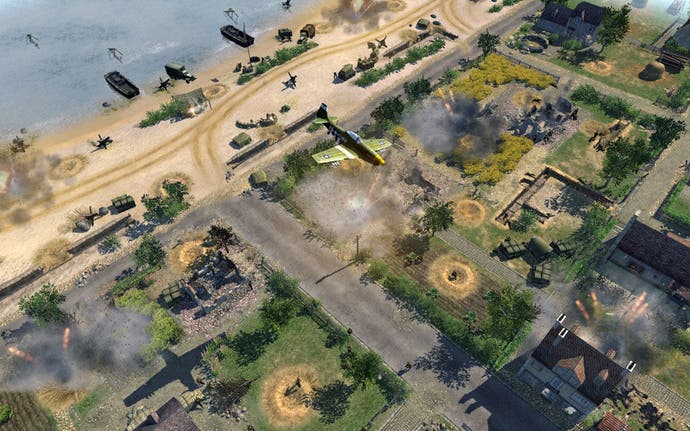Men of War: Assault Squad
Hell Alamein.
Digitalmindsoft's ongoing World War II real-time strategy series always did a spiffing job of streamlining the RTS experience. The total lack of any base construction leaves you to focus on the business of war, and Assault Squad, Men Of War's second standalone expansion, feels like a distillation of the experience.
For those unfamiliar with the way Men Of War plays, here's the boot-camp version. You begin at one end of the map and advance upwards, knocking out enemy units and fortifications and capturing strategic locations. These locations increase your drip-feed of requisition points, which in turn are spent on new units, which roll onto the table from your starting location.
Capturing strategic points also lets you delve deeper into the toybox, and order up more powerful – or more specialised – units to assist the war effort, which are lovingly recreated from their real-world counterparts.
But before you start slavering over Churchills and King Tigers, it's worth noting that these battles aren't won by armour, or indeed any unit, alone. Assault Squad offers a brutal denial of the tank-rush mentality, and it's consistently pleasing. Most basic infantry carry a limited amount of anti-tank grenades, and elite infantry – who'll get a paragraph or two to themselves in short order – tend to pack nation-specific anti-tank rifles or rockets. Man-hauled anti-tank guns have enormous ranges, and so long as there are infantry units close enough to do the spotting, they can knock out armour from a country mile away.
This really forces you to play a game of combined arms. While there are circumstances in which an armoured thrust can work, you generally need to support your armour with infantry. They keep enemy troops at bay, and represent a far cheaper and more efficient method of knocking out anti-tank guns. No unit fights alone in this game, and if it does, you can pretty much kiss it goodbye.

Every advance becomes a chewy little equation, in which you scope out the forces nestling in the area you wish to occupy, and work out in which order to commit your own forces. Strategic point B may be protected by a couple of units of entrenched infantry and an anti-tank gun; pretty standard, but if you charge your armour in, it'll brew up in a second. Knock out that AT gun with a fearless grenadier rush however, and your tank is free to harass and suppress the entrenched infantry from a distance. Then you can send your troops in to sweep the trenches and occupy it themselves.
That's a commonplace and elementary example. Factor in overlapping fields-of-fire from enemy AT guns, infantry vulnerability out of cover, the horror of long-range weapons such as the German 88 and a really quite aggressive AI, and the battlefield becomes a telescoping series of engagements that never really let you rest on your laurels after a successful push. I frequently find my forces a little spent through the process of capturing a strategic point, only to face a fierce counter attack that winkles me back out again. Even on the easiest setting, the AI refuses to sit still, and the closer to his back-line you get, the harder he counter-attacks.
This is why the process of recyling is so very important. The majority of damaged vehicles are repairable; more often than not, they've had a track-section knocked out, or have taken a repairable dink in the turret. As your front line rolls over yesterday's killing-ground, you find yourself with increasing numbers of damaged enemy tanks just sitting around.

As unlikely as it sounds, any infantry unit can be ordered to step up and repair these. It takes a long time – often up to ten minutes – to get it back up and running, at which point, you can crew it with infantry and turns the guns on its original owner. With a diligent eye you'll frequently find your armour is 50 per cent foreign by the closing stages.
Likewise, infantry are as prone to wounding as they are to instant death, and if you've a medic handy, you can run him around to patch up still-breathing casualties. There's a rare pleasure to tidying up after a brutal skirmish and finding you've enough troops to form a fresh squad (though one imagines the poor, ventilated fellows feel far from fresh). Those who prefer the broad brushstrokes of StarCraft II to any real kind of micro-management will have to reset their expectations, but getting stuck into details such as these transforms your chances in the long run.








